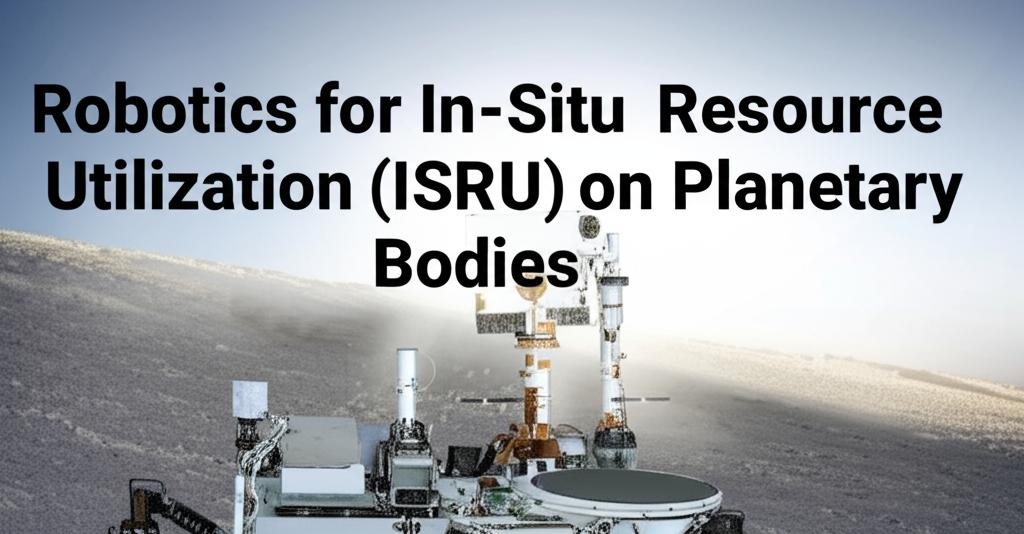In-Situ Resource Utilization (ISRU) represents a foundational shift in space exploration, moving from missions solely reliant on Earth-brought supplies to those capable of harnessing resources found directly on celestial bodies like the Moon and Mars. Robotics, particularly autonomous systems enhanced by artificial intelligence (AI), are the cornerstone technology making ISRU feasible and sustainable. Utilizing local resources—such as water ice, minerals in the regolith (soil), and atmospheric gases—can drastically reduce the cost and complexity of long-duration missions by producing essentials like water, oxygen, rocket propellant, and even construction materials on-site.
The Crucial Role of Autonomous SystemsThe vast distances involved in planetary exploration introduce significant communication delays, making real-time remote control impossible. Robots designed for ISRU must therefore possess high levels of autonomy. AI and machine learning enable these robotic systems to navigate challenging terrain, identify hazards, make independent decisions, and perform complex tasks without constant human intervention. NASA's Mars rovers, like Perseverance and Curiosity, already utilize AI for autonomous navigation, demonstrating the viability of these systems in unpredictable environments. Future robotic explorers are expected to feature enhanced machine learning capabilities, allowing them to adapt their actions based on new environmental data.
Key Robotic Applications in ISRURobotics are integral to nearly every stage of the ISRU process:
- Prospecting and Exploration: Robots, often working cooperatively, are tasked with identifying and characterizing resource deposits. This involves navigating surfaces, deploying sensors to detect volatiles like water ice, and mapping resource locations precisely. NASA's upcoming Cooperative Autonomous Distributed Robotic Explorers (CADRE) mission aims to demonstrate cooperative exploration techniques using multiple rovers on the Moon.
- Excavation and Collection: Specialized robotic systems, including excavators and drills, are needed to access and collect raw materials like regolith or ice. These robots must operate reliably in harsh conditions, dealing with abrasive dust and extreme temperatures. NASA is actively developing and testing technologies for excavating lunar regolith to access water ice deposits.
- Processing and Manufacturing: Once collected, materials must be processed. Robotic systems manage the transfer of materials to processing plants where, for example, water can be extracted from regolith through heating, or oxygen can be produced from Martian atmospheric CO2 (as demonstrated by the MOXIE experiment on the Perseverance rover). Robots are also key to proposed in-space manufacturing, potentially using 3D printing techniques with processed regolith to build habitats, landing pads, tools, and other infrastructure.
- Transportation and Logistics: Fleets of robotic haulers may be required to transport raw materials from excavation sites to processing facilities and move finished products (like water or propellant) to storage or usage points. Multi-robot coordination is essential for efficient logistics.
- Construction and Infrastructure Development: Robots powered by AI are envisioned for building essential infrastructure, such as landing pads, habitats, and research stations, using locally sourced materials. This reduces the immense cost and difficulty of transporting bulky construction supplies from Earth.
Significant progress is being made in developing and demonstrating ISRU robotics:
- Multi-Robot Systems: Competitions like the NASA Space Robotics Challenge (SRCP2) have spurred the development of software for coordinating teams of autonomous robots performing ISRU tasks in simulated lunar environments. Projects like CISRU (Collaborative In-Situ Resources Utilisation) focus on software managing multiple autonomous robots for sensing, navigation, and material handling.
- Innovative Concepts: The "World Is Not Enough" (WINE) concept explores a spacecraft that mines water from planetary bodies and uses it to create steam for propulsion, enabling it to "hop" between locations and refuel itself.
- Advanced Components: Companies like Honeybee Robotics are developing critical systems such as lunar drills, robotic arms, and power systems (like the Lunar Array Mast and Power System - LAMPS) essential for ISRU operations.
- Field Testing: Analog missions, like those conducted by NASA in volcanic terrains in Hawaii, test ISRU hardware and operations in environments that simulate lunar or Martian conditions. ESA's Space Resources Challenge focuses on robotic systems for collecting and processing lunar regolith simulant.
Future trends point towards increasingly sophisticated autonomous systems, including swarm robotics where large numbers of simpler robots collaborate on tasks. The integration of AI will continue to enhance decision-making, adaptability, and the ability of robots to maintain themselves and surrounding infrastructure.
Challenges AheadDespite the advancements, significant challenges remain. Operating robots reliably in extreme temperatures, vacuum, abrasive dust environments, and low gravity requires robust and durable designs. Power generation and management are critical constraints, especially during long lunar nights or Martian dust storms. Ensuring the long-term autonomy and reliable coordination of complex multi-robot systems is a major software and AI challenge. Finally, the high cost of developing, launching, and deploying these sophisticated robotic systems remains a significant hurdle.
In conclusion, robotics are indispensable for realizing the potential of In-Situ Resource Utilization. By enabling the autonomous finding, extraction, processing, and use of resources on the Moon, Mars, and beyond, these technologies are paving the way for a sustainable, long-term human presence in space, transforming how we explore and potentially inhabit other worlds.

